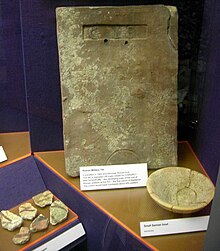Cohors I Baetasiorum

The Cohors I Baetasiorum [civium Romanorum] [ob virtutem et fidem appellata] ( German 1st cohort of the Baetasers [of the Roman citizens] [awarded for bravery and loyalty] ) was a Roman auxiliary unit . It is evidenced by military diplomas , inscriptions, brick stamps and the Notitia dignitatum . In the Notitia dignitatum it is referred to as Cohors prima Baetasiorum .
Name components
- Cohors : The cohort was an infantry unit of the auxiliary troops in the Roman army .
- I : The Roman number stands for the ordinal number, the first ( Latin prima ). Hence the name of this military unit is pronounced as Cohors prima ...
- Baetasiorum : the Baetaser . The soldiers of the cohort were recruited from the Baetas tribe when the unit was set up .
- civium Romanorum : the Roman citizen. The soldiers of the unit had been granted Roman citizenship at one point in time. However, this did not apply to soldiers who were accepted into the unit after this point in time. They received Roman citizenship only with their honorable farewell ( Honesta missio ) after 25 years of service. The addition appears in several inscriptions.
- ob virtutem et fidem (appellata) : for bravery and loyalty (excellent). The addition appears in an inscription.
Since there are no references to the additions to the name milliaria (1000 men) and equitata (partially mounted), it can be assumed that it is a Cohors quingenaria peditata , a pure infantry cohort. The nominal strength of the unit was 480 men, consisting of 6 Centuries with 80 men each.
history
The cohort was stationed in the province of Britannia . It is listed on military diplomas for the years 103 to 152/153 AD.
The unit was possibly set up after the suppression of the Batavian Uprising together with other auxiliary units and probably came to Britain with Quintus Petillius Cerialis . The first evidence in Britain is based on a diploma dated 103. In the diploma, the cohort is listed as part of the troops (see Roman Forces in Britannia ) that were stationed in the province. Further diplomas, dated 122 to 152/153, prove unity in the same province.
Roman citizenship was probably granted to the soldiers of the unit in the early reign of Antoninus Pius (138-161), when the border in Britain was moved north to the Antoninus Wall by Quintus Lollius Urbicus .
The diploma of 152/153 shows that the cohort together with the Cohors I Batavorum (or more likely vexillations from the two units) had been temporarily moved from Britain to the province of Mauretania Tingitana to take part in the suppression of an uprising.
The unit is mentioned for the last time in the Notitia dignitatum with the designation Cohors prima Baetasiorum for the Regulbio site. Under the direction of a tribune, it was part of the troops that were subordinate to the High Command of the Comes litoris Saxonici per Britanniam .
Locations
Cohort locations in Britannia may have been:
|
Members of the cohort
The following members of the cohort are known.
|
|
See also
Web links
- 2520 - Cohors I Baetasiorum c. R. Roman Inscriptions of Britain (RIB), accessed August 1, 2018 .
literature
- John Spaul : Cohors² The evidence for and a short history of the auxiliary infantry units of the Imperial Roman Army , British Archaeological Reports 2000, BAR International Series (Book 841), ISBN 978-1-84171-046-4
Remarks
- ↑ It is controversial whether appellata is to be regarded as part of this award.
Individual evidence
- ↑ Inscriptions with civium Romanorum ( AE 2013, 969 , CIL 3, 5331 , RIB 830 , RIB 837 , RIB 838 , RIB 842 , RIB 843 , RIB 2169 , RIB 2170 , RIB 3509 ).
- ↑ inscription whether virtutem et fidem appellata ( RIB 2170 ).
- ↑ Military diplomas from 103 ( CIL 16, 48 ), 122 ( CIL 16, 69 ), 124 ( CIL 16, 70 ), 135 ( CIL 16, 82 ) and 152/153 ( ZPE-199-187 ).
- ↑ a b c d John Spaul , Cohors², pp. 233, 236-237.
- ^ Jörg Scheuerbrandt : Exercitus. Tasks, organization and command structure of Roman armies during the imperial era. Dissertation, Albert-Ludwigs-Universität Freiburg im Breisgau 2003/2004, p. 157 Table 1 ( PDF ).
- ↑ Werner Eck , Andreas Pangerl, Paul Holder : A constitution from the year 152 or 153 for Lower Saxony and British troops, delegated to Mauretania Tingitana In: Zeitschrift für Papyrologie und Epigraphik , Volume 199 (2016), pp. 187-201, here p 195-196.
- ^ Notitia dignitatum in partibus Occidentis XXVIII ( online ).
- ↑ Margaret M. Roxan : Pre-Severan auxilia named in the Notitia Dignitatum In: British Archaeological Reports , Volume 15 (1976), pp. 59-80, here p. 73.
- ↑ Inscriptions from Alauna ( AE 2013, 969 , RIB 830 , RIB 837 , RIB 838 , RIB 842 , RIB 843 ).
- ^ Inscriptions from Bar Hill ( RIB 2169 , RIB 2170 ).
- ↑ Inscription from Old Kilpatrick ( RIB 3509 ).
- ↑ Bricks from Regulbium : stamp CIB ( RIB-02-04, 02468,1 , RIB-02-04, 02468,2 , RIB-02-04, 02468,3 ) and CI Baetasiorum ( AE 1969/70, 314 ).
